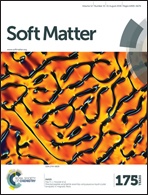Capillarity-driven flows at the continuum limit†
Abstract
We experimentally investigate the dynamics of capillary-driven flows at the nanoscale, using an original platform that combines nanoscale pores (⋍3 nm in diameter) and microfluidic features. In particular, we show that drying involves a fine coupling between thermodynamics and fluid mechanics that can be used to generate precisely controlled nanoflows driven by extreme stresses – up to 100 MPa of tension. We exploit these tunable flows to provide quantitative tests of continuum theories (e.g. Kelvin–Laplace equation and Poiseuille flow) across an unprecedented range and we isolate the breakdown of continuum as a negative slip length of molecular dimension. Our results show a coherent picture across multiple experiments including drying-induced permeation flows, imbibition and poroelastic transients.



 Please wait while we load your content...
Please wait while we load your content...